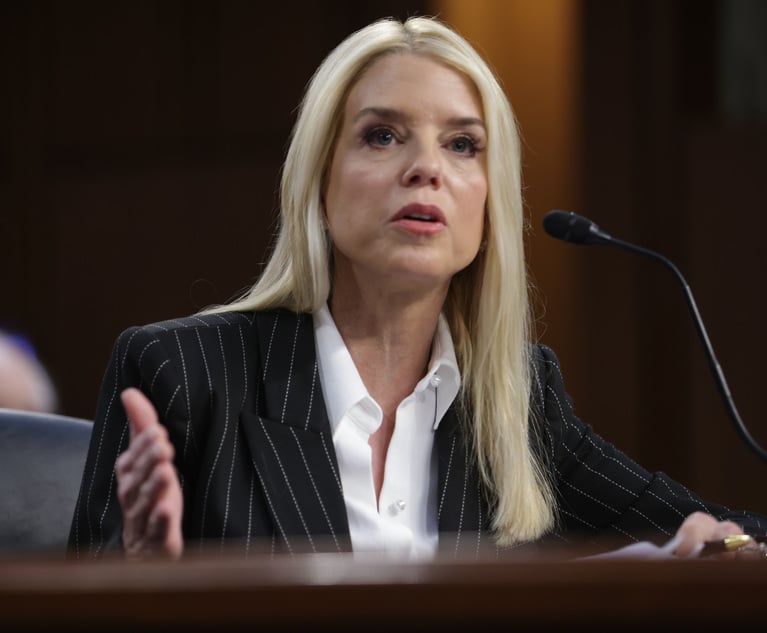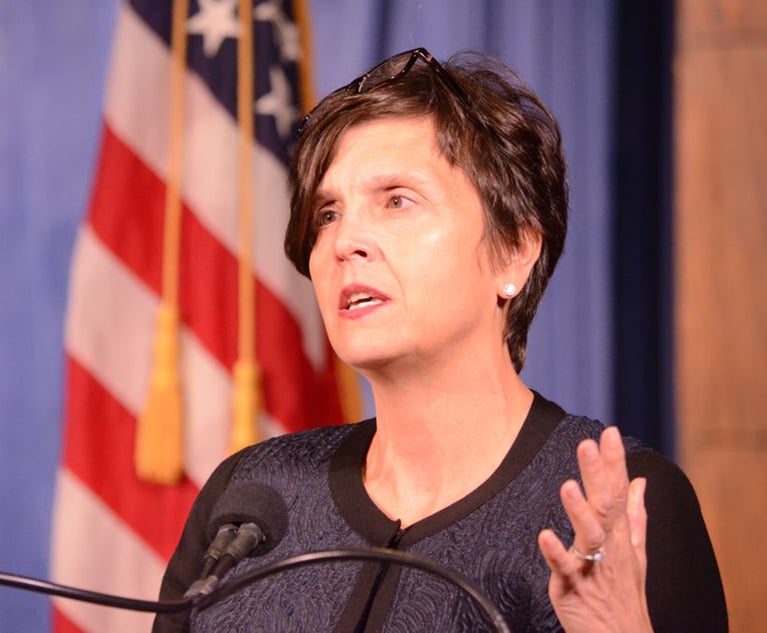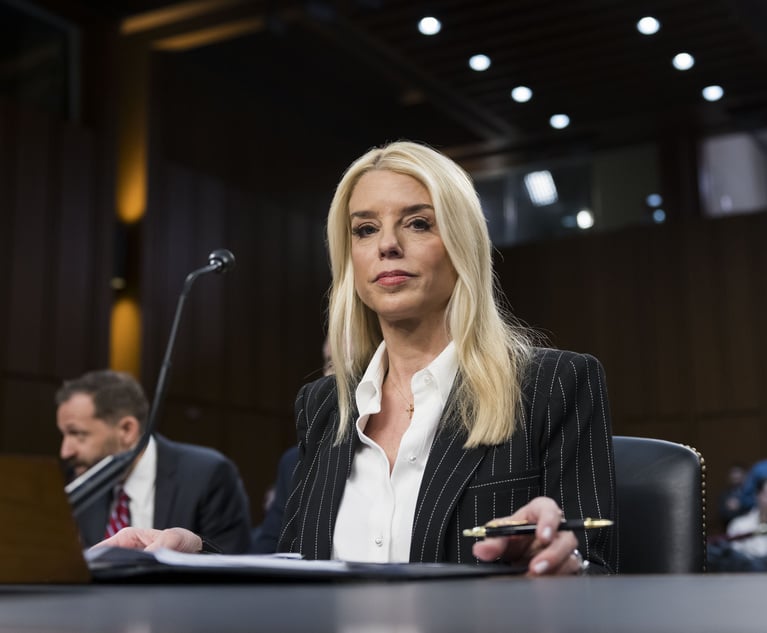Experts to Law Grads: Don't Freak Out About Public Service Loan Forgiveness—Yet
The U.S. Department of Education approved a mere 1 percent of initial Public Service Loan Forgiveness applications, but experts say the approval rate should increase over time.
October 11, 2018 at 04:23 PM
6 minute read
 (Photo: Shutterstock.com)
(Photo: Shutterstock.com)
Early numbers from the federal government's Public Service Loan Forgiveness program look grim.
Of the roughly 28,000 borrowers who applied to have their loans forgiven this year, a mere 289 were approved—or about 1 percent—and just 96 borrowers actually had their loans discharged.
Congress enacted the program in 2007 with the goal of helping people pursue often low-paying government and public service jobs by allowing them to discharge the remainder of the federal student debt after 10 years.
Despite the low forgiveness rate, law students and recent law graduates who are counting on the program to erase their student debt should not despair, according to student loan experts who say those early approval figures are essentially meaningless.
The biggest takeaway from the initial figures the Education Department reported late last month is the sheer amount of confusion and misinformation that surrounds the program, the experts say. Only a small number of people were ever going to meet the myriad requirements necessary to have their loans forgiven at the first opportunity due to how the program was set up. The fact that thousands applied signals that many people simply don't understand how it works, they said. (Those who believe they were wrongfully denied may supply additional information to the Education Department.)
“It's not indicative of what a likely approval rate is going forward,” said Chris Chapman, president of AccessLex Institute, an organization that advocates for the affordability of legal education.
“It's not indicative of some draconian interpretation of the law to keep everyone out, even if you're otherwise qualified. All those years ago, it wasn't clear to people what they should be doing. Going forward, it's very easy to comply and check the boxes if you know what you need to do. I don't think it's a problem.”
Heather Jarvis, an independent student loan adviser who has tracked the program since its inception, said she was surprised by the sheer number of people who submitted applications to have their loans forgiven, given the program's early narrow scope.
“That shows the desperation and need they have for some relief,” she said. “It would be really surprising to me if a lot of people had met the requirement at this point. That's just not how it was ever going to be. I'm talking to a lot of people who now feel like there is some discretion on the part of the Department of Education [to approve or deny loan forgiveness applications], and there really isn't.”
The Education Department released only a handful of figures pertaining to the initial cohort of loan forgiveness applicants. Of the nearly 33,000 applications submitted, about 20,000 were denied for failing to meet the requirements of the program. Another 8,000 were denied because they were missing information, according to the Education Department. In total, $5.5 million in federal loans have been discharged under the program.
Critics have faulted the program for being convoluted and confusing for students. Among the requirements:
- Borrowers must have Federal Direct Loans, which were uncommon in 2007 when the program came online. Two-thirds of higher education institutions in 2007 instead offered Federal Family Education Loans.
- Borrowers also have to be enrolled in an income-based repayment plan in order to qualify for loan forgiveness. In 2007, this option was called income-contingent repayment and it came with higher monthly payments than other plans. Thus, it was less attractive to borrowers.
- Borrowers must also make 10 years of on-time payments while working at qualified public service employers. However, the Education Department had no process for tracking qualified employment for the first five years of the program.
Those requirements were particularly difficult to meet for 2007 graduates—those now applying for forgiveness—because the program was new and information was scarce, Chapman said.
“It really revolves, I think, around the failure of the Department of Education to think about how they were going to implement it and how they were going to determine who qualified and who didn't in the years after it was enacted,” he said. “The earliest cohort will be the most challenged in accessing this benefit.”
An Education Department spokesman did not respond to requests for an explanation of the low approval rate of loan forgiveness applications.
AccessLex is holding four webinars in October geared toward helping these early borrowers navigate the system.
Some applicants for loan forgiveness likely don't have a strong handle on the program and applied in hopes that they met the criteria, Chapman and Jarvis said. Still others may have realized that they didn't qualify, but needed to get officially denied in order to access a program Congress recently authorized to assist public service workers who accidentally signed up for the wrong repayment plans but whom otherwise would qualify for forgiveness. Lawmakers set aside a $350 million fund to cover loan forgiveness for those borrowers, but the money is on a first-come-first-serve basis, meaning early applicants have a better shot of taking advantage it.
Those unique dynamics mean it's nearly impossible to glean useful information about the future of the program from the limited data release by the Education Department, the experts said. But both Jarvis and Chapman agreed that approval rates for the program should increase over time—good news for current students and recent graduates.
“The requirements are clear, but they are many and they are detailed,” Jarvis said. “As long as an individual borrower is well-informed and takes the steps necessary to make sure they have the right kinds of loans and enrolled in the right kind of repayment plan, and that they are eligible full-time employment, then public service loan forgiveness can be achieved.”
The bigger concern for recent borrowers should be the future of the program itself and the availability of federal student loans, Chapman said. Republican lawmakers have proposed eliminating loan forgiveness and capping federal graduate loans at $28,000 a year, though that legislation is on hold during election season. Chapman predicted that the program will survive thanks to bipartisan support, but it may well be curtailed in some ways.
Jarvis said the latest Education Department figures are a reminder to borrowers that they must mind the details.
This content has been archived. It is available through our partners, LexisNexis® and Bloomberg Law.
To view this content, please continue to their sites.
Not a Lexis Subscriber?
Subscribe Now
Not a Bloomberg Law Subscriber?
Subscribe Now
NOT FOR REPRINT
© 2025 ALM Global, LLC, All Rights Reserved. Request academic re-use from www.copyright.com. All other uses, submit a request to [email protected]. For more information visit Asset & Logo Licensing.
You Might Like
View All
Skadden and Steptoe, Defending Amex GBT, Blasts Biden DOJ's Antitrust Lawsuit Over Merger Proposal
4 minute read
'Lack of Independence' or 'Tethered to the Law'? Witnesses Speak on Bondi
4 minute read
Trending Stories
Who Got The Work
J. Brugh Lower of Gibbons has entered an appearance for industrial equipment supplier Devco Corporation in a pending trademark infringement lawsuit. The suit, accusing the defendant of selling knock-off Graco products, was filed Dec. 18 in New Jersey District Court by Rivkin Radler on behalf of Graco Inc. and Graco Minnesota. The case, assigned to U.S. District Judge Zahid N. Quraishi, is 3:24-cv-11294, Graco Inc. et al v. Devco Corporation.
Who Got The Work
Rebecca Maller-Stein and Kent A. Yalowitz of Arnold & Porter Kaye Scholer have entered their appearances for Hanaco Venture Capital and its executives, Lior Prosor and David Frankel, in a pending securities lawsuit. The action, filed on Dec. 24 in New York Southern District Court by Zell, Aron & Co. on behalf of Goldeneye Advisors, accuses the defendants of negligently and fraudulently managing the plaintiff's $1 million investment. The case, assigned to U.S. District Judge Vernon S. Broderick, is 1:24-cv-09918, Goldeneye Advisors, LLC v. Hanaco Venture Capital, Ltd. et al.
Who Got The Work
Attorneys from A&O Shearman has stepped in as defense counsel for Toronto-Dominion Bank and other defendants in a pending securities class action. The suit, filed Dec. 11 in New York Southern District Court by Bleichmar Fonti & Auld, accuses the defendants of concealing the bank's 'pervasive' deficiencies in regards to its compliance with the Bank Secrecy Act and the quality of its anti-money laundering controls. The case, assigned to U.S. District Judge Arun Subramanian, is 1:24-cv-09445, Gonzalez v. The Toronto-Dominion Bank et al.
Who Got The Work
Crown Castle International, a Pennsylvania company providing shared communications infrastructure, has turned to Luke D. Wolf of Gordon Rees Scully Mansukhani to fend off a pending breach-of-contract lawsuit. The court action, filed Nov. 25 in Michigan Eastern District Court by Hooper Hathaway PC on behalf of The Town Residences LLC, accuses Crown Castle of failing to transfer approximately $30,000 in utility payments from T-Mobile in breach of a roof-top lease and assignment agreement. The case, assigned to U.S. District Judge Susan K. Declercq, is 2:24-cv-13131, The Town Residences LLC v. T-Mobile US, Inc. et al.
Who Got The Work
Wilfred P. Coronato and Daniel M. Schwartz of McCarter & English have stepped in as defense counsel to Electrolux Home Products Inc. in a pending product liability lawsuit. The court action, filed Nov. 26 in New York Eastern District Court by Poulos Lopiccolo PC and Nagel Rice LLP on behalf of David Stern, alleges that the defendant's refrigerators’ drawers and shelving repeatedly break and fall apart within months after purchase. The case, assigned to U.S. District Judge Joan M. Azrack, is 2:24-cv-08204, Stern v. Electrolux Home Products, Inc.
Featured Firms
Law Offices of Gary Martin Hays & Associates, P.C.
(470) 294-1674
Law Offices of Mark E. Salomone
(857) 444-6468
Smith & Hassler
(713) 739-1250









